I run a business called Fairwill Display. We manufacture store fixtures in China. Many of our clients are overseas smoke shops. They care about quality and price. That’s where we come in. I want to explain what visual merchandising does for your store. It’s not just decoration. It’s a sales strategy. It changes how people see and buy your products. Here, we will discover what visual merchandising do to attract customers and increase sales in smoke shops using affordable glass showcases.
Table of Contents
ToggleThe Power of First Impressions


What does visual merchandising do? It sets the tone the moment someone walks by. In a smoke shop, that first look matters. Customers judge your store before they step inside. I’ve learned that a well-dressed store entrance pulls people in. A weak one pushes them away. Let’s explore how to master first impressions using visual merchandising.
Curb Appeal Starts the Conversation
The storefront is your silent salesperson. It speaks even when you don’t. What does visual merchandising do here? It makes strangers curious. It makes them stop. Smoke shops often sit next to other businesses. That makes it easy to blend in and be forgotten. A clean, creative, and bold storefront sets you apart. It invites people in.
Use large glass windows. They should showcase your most unique or popular items. Use angled glass showcases for better visibility. Bright lighting inside the case draws attention, even from far away. Bold signage also helps. Your logo should be clear and readable. If your smoke shop has a niche, reflect it in your signage. Don’t just say “Smoke Shop.” Say more. Try “Modern Vapes & Glass Art” or “Premium Hookah Accessories.”
I recommend staying consistent. Keep the outdoor theme aligned with what’s inside. If your inside is clean and modern, the outside should match. Dusty signs or flickering lights kill curiosity. Customers walk past without a second glance. Add visual depth. That means having layers in your window displays. Show a hero product in front. Support it with themed items behind. This creates depth and draws the eye inward.
In short, what does visual merchandising do? It grabs attention from the street. And that’s where selling starts.
Entrance Zones Build the First Impression
Once someone steps inside, you only have seconds to win them. This is where your entrance layout matters. What does visual merchandising do in this zone? It makes the shopper feel welcome and intrigued.
The entrance area should feel open. Avoid placing tall fixtures right in front. This makes the space feel blocked. Instead, use lower glass counters or angled showcase units. These still highlight products without making the area feel tight. Use this zone to show new arrivals or seasonal products. People naturally stop near the entrance. That pause is your chance to impress.
Make the space smell good. The scent is a part of visual merchandising too. Clean air or a light hint of incense creates an atmosphere. It adds emotion to the visit. Lighting plays a key role again. Ensure the front of the store is brighter than the rest. This pulls customers in like a stage spotlight. Their eyes follow the light and your layout should guide their steps.
What does visual merchandising do when done well? It encourages flow. The entrance zone should naturally lead to the main product areas. Don’t confuse customers. Help them move in without hesitation. Use brand colors and welcome signage. If you have promotions, highlight them here. Use clear posters, acrylic sign holders, or digital screens. Keep them aligned with the overall vibe. Remember, this zone is not for clutter. It’s for focus. Start the journey strong.
Product Grouping Makes Displays Cohesive
Group items that belong together. What does visual merchandising do in this context? It tells stories. It makes browsing easier and shopping more logical.
A chaotic layout frustrates buyers. It makes them leave faster. But when things are grouped, customers feel relaxed. They understand what they’re seeing. Let’s say you sell vape gear. Place coils, liquids, and devices near each other. Use small shelves or glass boxes inside your main display to separate each item clearly. It helps shoppers find what they need without asking.
Color grouping also works well. Keep similar colored products together. This pleases the eye and makes the store look organized—place signage near each group. Use simple descriptions. Write product names, prices, and features. Don’t overload the signs. Keep the message short and clear. You’re not giving a lecture. You’re showing value.
Slatwall merchandisers work great for vertical grouping. Use them for accessories like grinders, lighters, or rolling trays. Keep heavier items lower and lighter ones higher.
Try not to mix themes in one space. If you’re displaying hookah pipes, don’t mix them with bongs. Keep the mood and function aligned. This helps customers identify what interests them fast. What does visual merchandising do here? It reduces confusion. It speeds up buying decisions. And it makes your smoke shop look professional.
Cleanliness and Order Signal Professionalism
Dust kills sales. Smudged glass turns customers away. What does visual merchandising do with cleanliness? It shows you care. You can have great products, but if they’re poorly displayed, they won’t sell. Clean showcases say, “These products matter.” Dirty ones say, “We don’t care.”
Make daily cleaning part of your routine. Wipe down the glass. Sweep the floor. Organize products inside every shelf. Clean spaces make people stay longer. They also help you spot broken or missing items fast. Use dividers inside your glass display cases. These keep things neat and make each item pop. Small display risers work well too. They give height to products and add visual variety.
Avoid putting too many products in one case. Give each item space to breathe. Crowded displays confuse the eye and reduce appeal. Label everything clearly. Price tags should be legible and straight. If a customer needs to ask for prices, they may walk away. Good visual merchandising answers questions before they’re asked.
Replace broken bulbs fast. Nothing says neglect like a dark showcase. Lighting is half the appeal. If the light fails, the whole case looks dull. Also, keep your packaging neat. If you sell boxed products, make sure the boxes are clean and upright. Bent corners or torn wraps lower perceived value. In summary, what does visual merchandising do in terms of cleanliness? It turns effort into trust. Customers feel safe and respected in a clean shop.
Transitions Shape the Shopper’s Journey
From the sidewalk to the checkout, each step should feel natural. What does visual merchandising do in shaping this journey? It creates flow. It leads the customer gently through your store.
Use floor paths. Lay rugs, tiles, or signs to show movement. People follow visual cues. Place bestsellers along this path. They’ll get noticed more. Design with zones. Have a vape area, a hookah area, and an accessories area. Each should feel distinct but connected. Think of your store like chapters in a book.
Use focal points. Every few feet, add a feature—like a tall glass case with rare products. This stops the eye and creates interest. It also gives your team talking points. Your store should feel spacious, even if it’s small. Avoid placing large counters back-to-back. Give people room to move. When shoppers feel relaxed, they spend more time exploring.
Use mirrors to make the space feel bigger. Place them behind your glass cases. They reflect light and products. That adds depth without adding clutter. Install wheels on some fixtures. That lets you refresh the layout often. Small changes keep the store fresh. People notice when things look new.
And finally, what does visual merchandising do with transitions? It keeps customers engaged. It lets them flow naturally, which increases time spent inside—and more time often means more sales.
Emotional Impact Wins the Sale
What does visual merchandising do beyond showcasing products? It creates emotion. Emotion drives buying.
Let’s start with the senses. The sight is obvious. But what about smell and sound? A light scent of incense can create calm. Background music can build a vibe. These small details add up. Display your products with care. Give your best items a “stage.” Use lighting, risers, and contrast. A shiny vape kit on a matte base looks sharp. That contrast tells the customer it’s special.
Add storytelling elements. If you carry handcrafted pipes, share a note about the maker. This makes the item feel personal. People buy stories more than features. Use themed displays. For example, build a “Starter Kit” corner. Include an affordable vape, coils, and e-liquid. Arrange them neatly in a dedicated showcase. Add a sign: “Perfect for First-Time Users.”
This shows you understand customer needs. That creates trust. And trust builds loyalty. Use display screens to show product videos. If your supplier provides them, great. If not, create simple clips. Show how the item works. A 20-second video can convert browsers into buyers. Make sure every corner of your store feels intentional. Random displays feel cold. Curated spaces feel inviting. That emotional pull can turn curiosity into commitment.
So again, what does visual merchandising do? It connects product with feeling. And that connection drives sales more than logic alone.
Organizing Products to Guide Buying Decisions
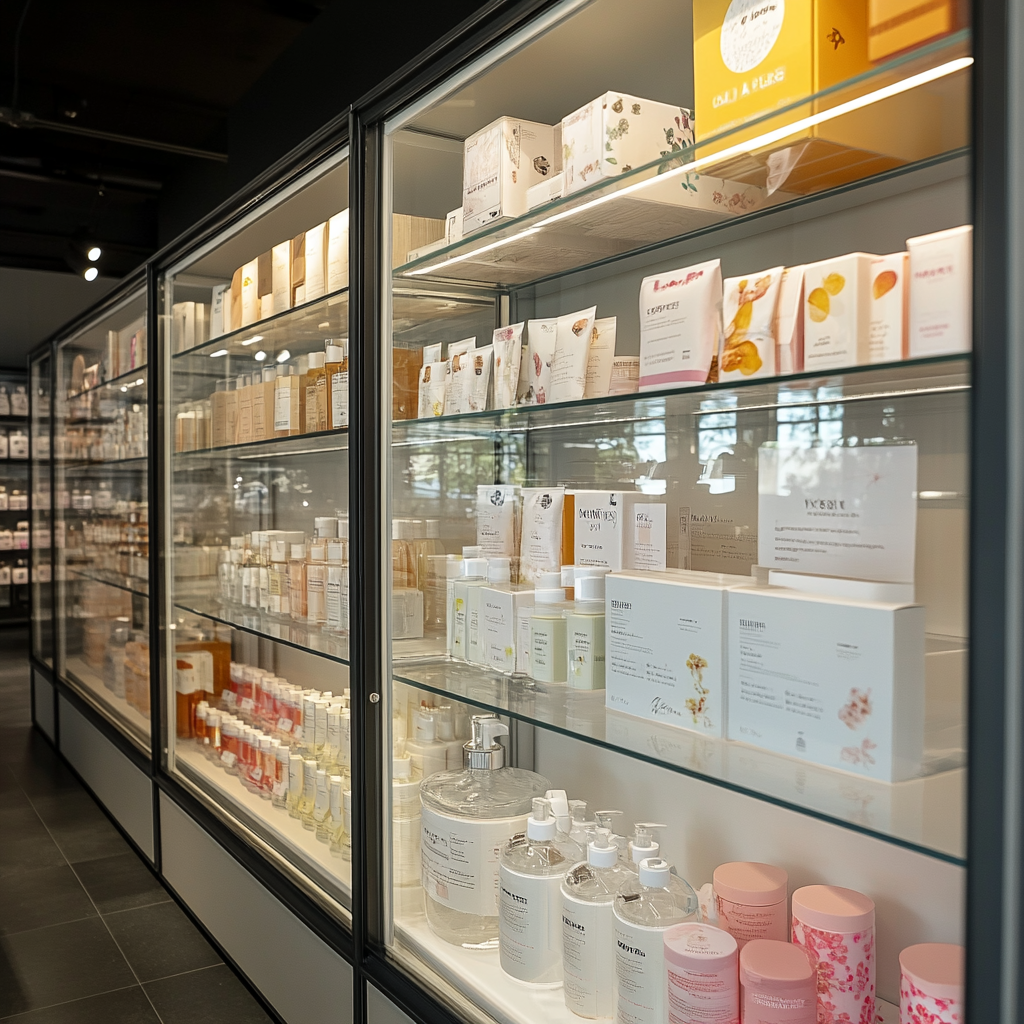

What does visual merchandising do? It makes shopping feel simple. When smoking shop customers know where to look, they feel relaxed. That’s when buying starts. Good organization isn’t just about space. It’s about decisions. The layout can push customers toward the items you want to sell. I’ll explain how.
Layout Zones That Reflect Buyer Intent
Let’s start with your floor plan. What does visual merchandising do here? It creates purpose. It makes each zone speak to a different need.
Put bestsellers in the center. That area gets the most attention. Use glass showcases to highlight popular vape devices or water pipes. Customers see these first and often ask questions. Reserve the back wall for high-end or specialty items. That area requires effort to reach. Curious shoppers will go the distance. Place LED-lit showcases to make these items feel premium.
Keep impulse buys near the register. Things like rolling papers, lighters, or small accessories work great here. Use a clear acrylic counter display or a glass cube. These draw attention while waiting in line. Use floor arrows, rugs, or shelf colors to separate zones. People like visual guidance. That makes navigation natural. It removes the awkward “Where do I go?” feeling.
Designate one area for new products. Label it clearly. Use large signs or lightbox displays to say “Just In” or “Latest Arrival.” This invites exploration and sparks curiosity. When you organize by intent, shoppers don’t feel lost. They feel smart. That builds trust and encourages buying.
In short, what does visual merchandising do? It removes friction from the buying process. It speaks to needs without using words.
Grouping Products by Function and Category
What does visual merchandising do with product grouping? It gives structure. And structure leads to smart decisions.
In a smoke shop, you sell many items. They must not feel scattered. Keep similar products together. If someone shops for hookah pipes, they should see all sizes in one place. Not mixed with grinders. Use glass cabinets for fragile or valuable items. This includes vape kits, custom bongs, or glass bowls. Use slatwall panels for hangable items like rolling trays or tools.
Sort by category: dry herb gear, vape accessories, hookah items. Then break each down by function. For example:
- Dry herb: grinders, containers, rolling papers
- Vape gear: mods, coils, tanks
- Hookah: hoses, bowls, bases
Make it easy to scan. That speeds up buying. Use risers or shelf levels to keep smaller items visible. Don’t hide them in a corner. Also, group by use case. Create a “Starter Zone” with everything a beginner needs. Offer kits in glass cases with tags like “Perfect for New Smokers.” Show value and convenience.
Use simple dividers. Clear acrylic shelves work great. These help define groups without adding bulk. What does visual merchandising do in this setup? It organizes the chaos. It turns variety into clarity. The clearer your grouping, the more likely shoppers will buy more than one item. That’s how you increase order value naturally.
Creating Logical Flow from Entry to Checkout
Flow matters. What does visual merchandising do with the flow? It guides the journey. From the moment customers step in, they should feel led.
Start with a visible path. Avoid sudden turns or blocked walkways. Use angled display fixtures to naturally guide motion. Curved showcases help direct foot traffic without force.
Use product storytelling along the route. Start with bold, colorful items. Then show related accessories. For example:
- Entry: new vape flavors
- Middle: vape devices
- Near checkout: coils and chargers
This mirrors decision stages—interest, product, and support items. Customers follow the logic. They don’t need to think hard.
What does visual merchandising do with this flow? It matches behavior. Shoppers want easy choices. If they need to jump between shelves, they get tired and leave. Use visual cues like arrows or hanging signs. Add small signs on shelves: “Complete your kit,” “Try these next,” or “Customer favorites.” These encourage action. At the end, near the counter, keep display trays of small products. These turn waiting time into extra sales time.
Also, create stops or “discovery zones.” These are spots where people naturally pause. Use them for promotions or seasonal items. Change them often. The goal is to keep momentum. Don’t make customers double back. One clear path from start to finish works best.
Balancing Visibility and Security in Product Placement
Many smoke shop items are small or valuable. You need both access and protection. What does visual merchandising do here? It balances display with security.
Put premium items in locked glass showcases. Make sure the lighting is bright. Use mirrors in the back to add depth. This draws attention without allowing easy touch. If products don’t need locking, use open shelving. But keep it clean and elevated. Place expensive items at eye level. Place bulk items lower. That matches how people scan shelves.
Add labels under each item. This avoids too much touching. Use printed tags inside glass counters. Include names, prices, and quick details. This keeps everything organized. For high-theft items, place them close to staff areas. That includes rare pipes, vapes, or limited editions. Staff presence deters theft.
Use security cameras as a visible deterrent. Customers behave better when they know they’re watched. Still, don’t create a cold vibe. Stay welcoming. For small accessories, try lockable glass cubes on countertops. These allow display protection. You can even rotate them daily for freshness.
Also, consider adding QR codes for digital info. Customers can scan to learn more. That reduces questions and keeps hands off the glass. With the right balance, you get trust and security at once. Customers feel invited. You feel in control.
Using Signage to Support Buying Decisions
Clarity sells. Confusion costs. What does visual merchandising do with signage? It gives answers. It turns questions into purchases. Each section of your store should have a title. Use clear fonts and bold signs. For example: “Vape Zone,” “Glass Pipes,” “Hookah Central.” Keep it simple and visual.
Next, label every product group. Don’t just show products. Explain them. Use tags with three key points: what it is, how it’s used, and why it’s popular.
Example:
“Titan Mini Mod – Compact vape, long battery life, best for travel.”
That short message educates and persuades.
Use promotional signage wisely. Highlight new arrivals or bestsellers. Don’t overdo it. Too many signs become noise. Change them often to keep interest. Place signs above and below. Some people look up. Some scan shelves. Cover both. Use acrylic holders or lightbox signs for elegance. Digital screens work too. Loop product highlights or unboxing videos. These educate while entertaining. And they hold attention longer.
What does visual merchandising do with signs? It removes the guesswork. Customers get facts fast. That builds confidence. Don’t forget compliance signage. Age restrictions should be clear. Place “21+ only” notices near the entrance and vape section. This builds trust and avoids trouble. Use colors for impact. Red for discounts. Green for eco-friendly. Blue for new tech. Color-coded signs help people decide quicker. When signs talk, staff can focus on real questions. That makes your shop more efficient and inviting.
Offering Cross-Sells Through Strategic Positioning
Cross-selling is subtle. What does visual merchandising do with it? It places the right temptation in the right place.
If someone looks at a bong, nearby they should see cleaners or ash catchers. If they browse a vape, display coils and e-liquids beside it. It saves time and sparks ideas. Use tiered shelving for cross-sells. The main item goes center. Accessories go below and beside. Keep spacing tight so they feel linked.
Add signs that suggest bundles. Example:
“Complete Your Kit – Save 10% When You Buy Coils + Charger.”
These work well at eye level. People see them first.
Try bundles in one showcase. Arrange a “Starter Pack” or “Daily Combo.” Keep it neat. Don’t mix too many colors. Let each set feel intentional. Staff can also point out these groups. But your layout should make them obvious.
Near checkout, place small, low-cost add-ons. Try branded grinders, filters, or flavored tips. Use a rotating counter tray to hold them. Change it weekly to stay fresh. What does visual merchandising do here? It makes cross-sells look helpful, not pushy. Avoid hard upselling. Instead, use layout to suggest smart additions. When customers feel in control, they’re more likely to buy extra. With smart placement, every shelf works harder. And the average ticket goes up.
Using Colors, Lights, and Materials to Influence Mood
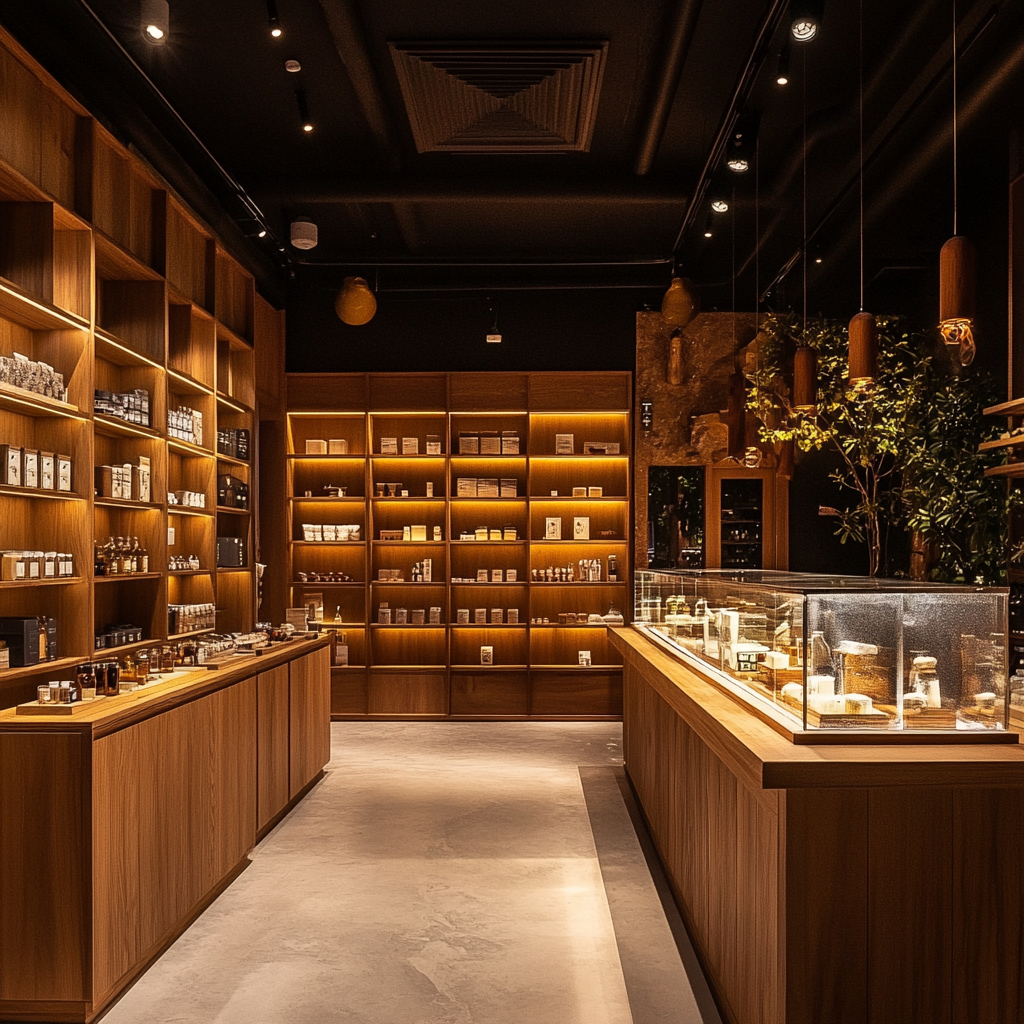

What does visual merchandising do? It builds mood. The right color, the right light, and the right material can change how customers feel. And that changes how they shop. Let me show you how to design a smoke shop that makes people stay, browse, and buy.
Choosing the Right Color Palette for Your Store
Colors trigger emotions. What does visual merchandising do with colors? It sets the mood the moment someone enters.
Cool colors like blue and green feel calm. They suit high-end or modern smoke shops. Warm colors like red or orange add energy. They help small spaces feel exciting. Neutral tones—like grey, black, and wood—add balance. I often see smoke shops mix matte black shelves with wooden counters. That mix creates contrast and style.
Don’t use too many colors. Stick to three main tones. One should dominate, one support, and one accent. This keeps your store from feeling loud or messy. For glass showcases, use light-colored frames if your products are dark. Use dark frames if your items are light. This adds contrast and makes products pop.
If you sell premium vapes, choose cool, high-tech tones. For hookah, try deep reds or gold. These choices align with the product’s vibe. Accent walls work well too. Paint one wall in your main color. Add shelves or signs on it. It makes your displays feel organized and intentional.
Using Lighting to Draw Attention and Set the Tone
Lighting matters more than most people think. What does visual merchandising do with lighting? It makes products shine. It also builds mood and structure.
Bright white light gives a clean, modern feel. It works great with glass showcases. Soft yellow light adds warmth. It suits shops that focus on hand-crafted or artistic items. Spotlights help you highlight key products. Aim them at bestsellers or seasonal picks. They act like mini-stages for your merchandise. You can place spotlights inside glass cabinets for extra sparkle.
Avoid dark corners. They feel neglected. Add under-shelf lighting or strip LEDs to bring those spaces to life. Motion lights also create excitement when activated. Color-changing lights can set a theme. Try cool blue lights for vape zones. Use warm reds in hookah areas. That keeps each section unique.
Lighting also affects movement. Bright paths guide shoppers through your space. Dimmer zones invite slower browsing. Keep bulbs consistent in tone. Mixing cool and warm bulbs makes the store look uneven. Choose one style and stick with it.
Choosing Store Fixture Materials That Match Your Brand
Materials talk. What does visual merchandising do with materials? It speaks your brand’s language. Glass shows elegance. It also adds security and visibility. That’s why we use tempered glass for showcases. It protects your items and lets them shine. Wood adds warmth. Many smoke shops use wood for shelves or counters. It feels classic and earthy. That suits hookah and hand-blown glass pieces. The metal feels strong and sleek. Brushed steel or black metal looks modern. It pairs well with high-tech vapes or digital accessories.
Use consistent finishes. Don’t mix shiny and matte in one space unless done with purpose. It can feel unbalanced. Also, think about texture. Smooth glass feels clean. Rough wood adds character. Soft fabric backdrops add depth to your display boxes.
Materials matter for durability too. Choose E1-grade boards for shelves and counters. They last longer and are safer for the environment. Use different materials to signal zones. A wood table for hookah gear. A glass counter for vapes. A black metal shelf for grinders and tools.
Coordinating Mood with Product Type and Customer Profile
Different customers want different feelings. What does visual merchandising do here? It aligns the mood with the product and the buyer.
Let’s say your store attracts young vapers. They want a modern, techy vibe. Use cool colors like blue or white. Pair with bright LED lighting and chrome materials. That feels clean and fresh. Older customers may prefer a more traditional space. Use warm tones. Try wood fixtures and soft lighting. It feels safe and welcoming.
Selling hand-blown glass? Make your store feel artistic. Use spotlighting. Display pipes in glass boxes with black velvet backgrounds. That makes each item feel like a collectible. For budget shoppers, make displays simple and clean. Use open shelves with clearly marked prices. Avoid over-decorating. They want clarity, not flair.
Also, think about mood shifts. What does visual merchandising do when customers enter and exit? It transitions them. Make the entrance bold. Make the checkout calm and quick. Match your decor to customer energy. If your crowd is lively, use bold signage and high-contrast colors. If they’re calm, make the space feel peaceful and slow-paced.
In short, tailor every visual detail to the mood you want customers to feel. When the space matches their expectations, they stay longer—and spend more.
Maximizing Space With Display Fixtures
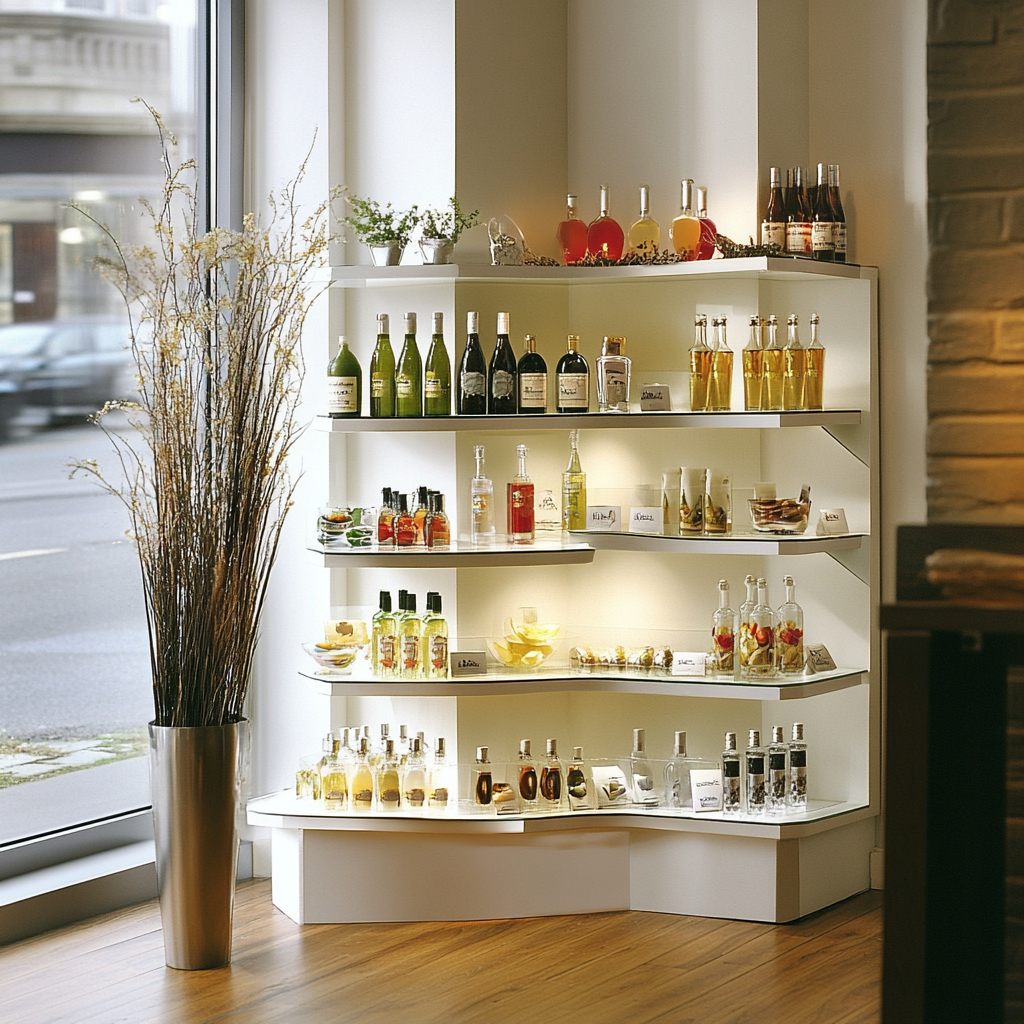
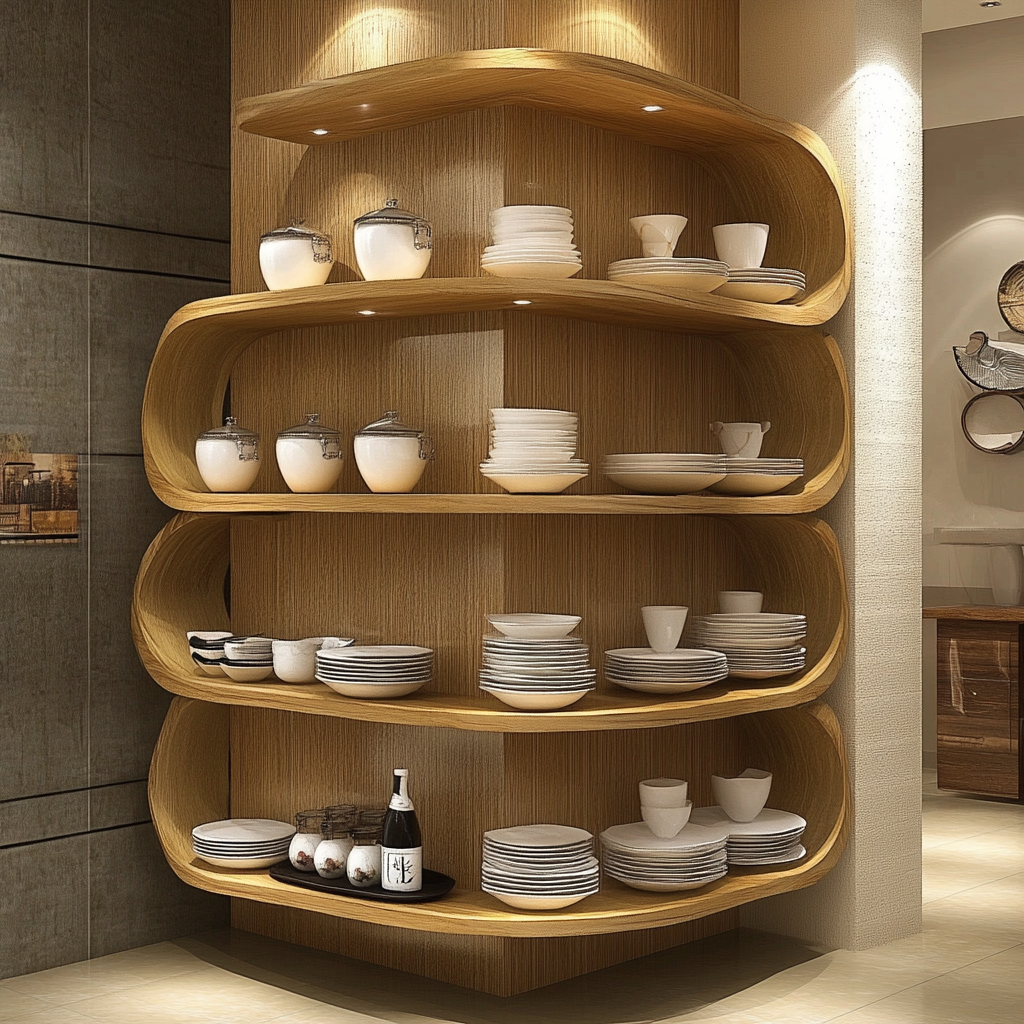
With smart planning, even small smoke shops feel open and full of choice. I’ll explain how to display fixtures to maximize your selling area without making your store look crowded.
Using Vertical Space to Create Depth
When floor space is limited, go up. What does visual merchandising do with vertical space? It builds layers and expands the view. Wall-mounted slatwall panels are a great start. They let you hang items like lighters, grinders, and pipes. Add shelves, hooks, and baskets to fit each product type.
Tall glass display cabinets also help. Use them to show off premium items. Place rare vapes or artistic pieces at eye level. Use the top shelves for lighter, less valuable items. Stackable displays are another tool. Use them for pre-packed accessories. Add labels to each level so customers don’t need to ask.
Don’t forget corner spaces. Install corner shelving or corner units. These often go unused but can hold plenty of small items. Use signs at different heights. One eye-level sign isn’t enough. Stack key info from top to bottom to match each shelf layer.
Lighting helps create depth. Install LED strips on vertical shelves. That draws attention up and down. It also prevents shadows from hiding products.
Designing with Modular Fixtures for Flexibility
Stores evolve. Stock changes. That’s why flexibility matters. What does visual merchandising do with modular fixtures? It gives you the freedom to adapt fast. Start with slatwall systems. You can move hooks, baskets, and shelves at any time. This allows you to change displays often. New arrivals? No problem. Just rearrange the hooks and go.
Gridwall fixtures offer similar benefits. These metal grids stand on floors or hang on walls. Add adjustable hooks or bins. Move them as needed. Perfect for rotating product types. Modular glass showcases also help. Choose units with wheels or detachable tops. You can move them for promotions or events. They let you reshape the store layout in minutes. Adjustable shelf racks are a must. Products come in all shapes and sizes. Being able to shift shelf height keeps displays clean and proportional.
Even modular counter displays work well. Try rotating stands or multi-level risers. These fit different product lines without needing extra floor space. Why does flexibility matter? It keeps your store fresh. Returning customers notice updates. That keeps them curious and engaged.
Choosing the Right Fixture for Each Product Type
Not every product fits every display. What does visual merchandising do here? It matches the right product with the right fixture.
Start with fragile items. Use locked glass cabinets. These protect products while keeping them visible. Perfect for pipes, high-end vapes, or handmade glass. For accessories, open shelving works well. Rolling papers, cleaners, or tips should be easy to reach. Use shallow bins or tilted trays to hold them in place. Use pegboards or slat walls for hanging items. These fit grinders, lanyards, small pouches, and more. Group by type and size to keep things tidy.
Countertop displays suit small impulse items. Try clear acrylic trays or multi-tier stands. Place them nearthe checkout or entrance zones. Heavier items like hookah bases need sturdy shelving. Use thick E1-grade boards or metal frames. Place them at hip level for easy viewing and lifting. Digital items like rechargeable vapes benefit from lit cases. Use built-in lights to make them stand out. Add signs that explain functions or charging time. Glass risers and mini-stages help with hero products. Elevate them above other stock. That adds focus and prestige.
Keeping Aisles Clear While Displaying More
Crammed stores lose business. What does visual merchandising do to prevent that? It balances visibility and space.
Start with aisle planning. Keep main aisles wide—at least three feet. Customers need space to walk, turn, and browse without bumping into things.
Use narrow, tall fixtures instead of wide ones. These hold more without blocking the path. Glass cases also keep sightlines open. Shoppers see across the store, which makes it feel bigger. Use nesting tables or stackable cubes for flexibility. Pull them apart during busy hours. Combine them again when space is tight.
Don’t place large fixtures directly in front of the entrance. Leave that area open to draw people in. Put your tallest displays along walls or corners. Use mirrors to reflect light and extend visual space. This trick makes even small shops feel open and airy.
Add labels and signs to reduce browsing time. Shoppers don’t want to guess where things are. Clear info means shorter searches and faster decisions. Install mobile fixtures when possible. Rolling displays give you control. You can shift them based on the season, promotion, or daily traffic.
Arranging Displays to Encourage Browsing
Flow makes a difference. What does visual merchandising do with the arrangement? It builds a path that feels natural and engaging.
Start with power zones. These are spots most people see first—like the front right after the entrance. Place popular items here. Use lighting and signage to grab attention. Use angled shelves to guide the eyes inward. Try “V” shaped arrangements. These make people feel surrounded and curious.
Keep displays at varying heights. Flat layouts get ignored. Raise a few items using risers or platforms. This adds energy and dimension. Use focal points to slow movement. A colorful hookah set or bold LED vape case can act as visual anchors. These stop shoppers mid-step.
Create “themed pods” around the store. For example, build a “Flavor Zone” with vape juice. Add a “Rolling Corner” with papers, trays, and containers. Themes add logic and fun. Rotate featured items weekly. This gives people a reason to come back. New displays create excitement—even for returning visitors. Use scent or sound to enhance the mood. Play soft music. Use scent diffusers for freshness. When the senses engage, shopping becomes a full experience.
Integrating Checkout Counters into the Fixture Plan
Your checkout counter is more than a transaction zone. What does visual merchandising do here? It turns to wait into buying. Use the space behind the counter. Install slat walls or shelves to show staff-only items. These might include specialty vapes, torch lighters, or limited-edition goods.
Add counter-height glass showcases. These display impulse buys—small grinders, trays, or novelty items. Use small lights to highlight them. Display small bundles. Try a “Smoker’s Mini Pack” with papers, filters, and a lighter. Keep them priced under $10. These move fast.
Use the front of the counter too. Add rotating trays or acrylic bins. Change items every few days. Frequent shoppers notice the change. Keep signage clean and clear. Add small price tags or bundle offers. Simple signs like “Top Seller” or “Staff Pick” build trust. If you use digital POS screens, add visual prompts. Show a photo of a new item with a short message: “Ask Us About This Week’s Deal!”
Building Brand Identity Through Visual Design
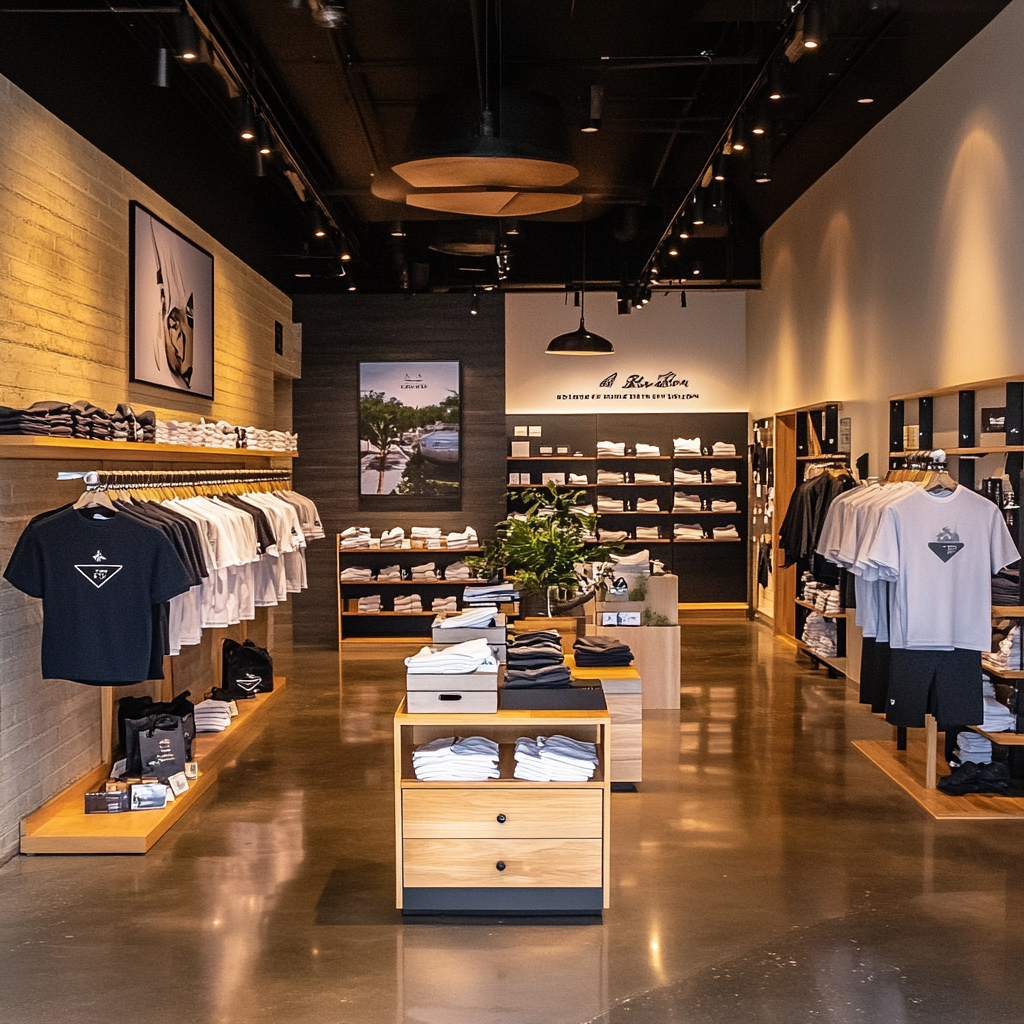
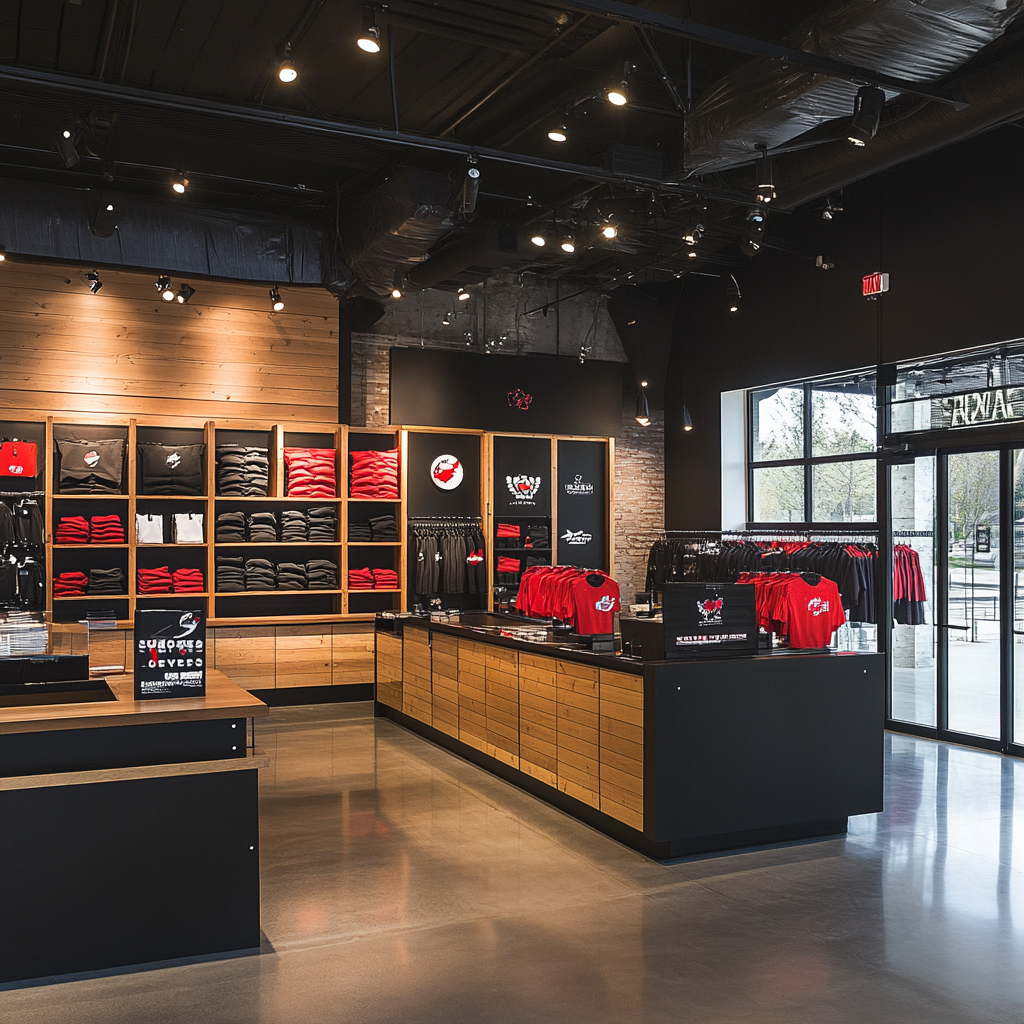
Every color, shelf, light, and texture becomes part of your voice. If your display looks strong, customers see you as strong. Let’s talk about how design builds a brand.
Reflecting Your Store’s Personality Through Fixtures
Fixtures are more than shelves. What does visual merchandising do with them? It turns them into silent storytellers. If you want to look premium, use glass and metal. Clean lines and bright lights say “high-end.” That works for rare vapes and custom glass pieces. Customers see value just by how it’s presented.
Want a relaxed, artistic vibe? Use wood finishes. Add warm lighting. Soft textures create comfort. Use curved displays to soften the layout. That suits hookah shops or artisan pipe sellers. For edgy, modern stores, go dark. Matte black walls. LED strips. Metal grids. These elements appeal to younger crowds. They shout boldness and style.
Match your materials to your brand. If you value eco-friendliness, use reclaimed wood. Add earthy tones. Show your care through every shelf and stand.
Using Repetition to Reinforce Your Message
Repetition builds memory. What does visual merchandising do with repetition? It plants your brand in your customer’s mind.
Start with colors. Use the same color tones across signs, price tags, and packaging. Don’t mix too many styles. Pick one theme and carry it everywhere. Next, repeat your logo. Place it on shelf signage, displays, and showcases. If you use branded trays or risers, that’s even better. Customers will start to connect the logo with trust.
If you have a slogan, use it often. Place it near the entrance. Add it to the checkout counter. Repeating the message helps people remember who you are. Fonts matter too. Choose one typeface for all print materials. Use it on signs, promotions, and shelf tags. This small detail strengthens your image.
Also, repeat layout logic. If you always group products by function, stick to it. Customers learn your system. That makes browsing feel easier. And ease builds trust. Use your best color as an accent across fixtures. A red edge, a blue stripe, a wood border—keep it consistent. It gives your shop a signature feel.
Designing Displays That Match Brand Values
Your values define your brand. What does visual merchandising do with that? It turns values into visuals. If you care about quality, show it. Keep everything neat and precise. Don’t let shelves overflow. Use clean lines. Use high-end materials like tempered glass and E1-grade boards. If you promote affordability, show value in your layout. Use clear prices. Place budget-friendly items up front. Group “Best Deals” into bundles. Let the design say, “Smart buys live here.”
If your shop supports the smoking lifestyle, make it a community space. Add a table with accessories. Let people try samples or see how products work. Use display boards to explain use and care. Support eco values with green tones and natural finishes. Add small plants. Use signs made from recycled materials. This sends a message without saying a word.
Add personal touches. Show a picture of your team or the story behind the business. A simple framed sign on the wall works well. That makes your brand human.
Making the Store Feel Unique and Memorable
Brand identity means standing out. What does visual merchandising do to make that happen? It adds unique elements no one forgets. Use custom colors. Even one wall in your brand color makes the space feel special. Pair that with matching trim or light boxes. A signature color becomes a landmark in the customer’s mind.
Create an icon wall. Hang the best products in a bold display. Frame them in light. Make them look like art. That becomes your photo wall. People share it online—and that spreads your brand. Add one “signature” fixture. It could be a circular glass counter. It could be a floating shelf display. Something no one else has. That becomes your visual hook.
Use scent to stay in memory. A distinct smell—maybe mint, vanilla, or fresh wood—makes your store unforgettable. People remember feelings, not facts. Offer branded packaging. Even a simple logo sticker on a bag adds value. People carry your name out into the world.
Blending Online and Offline Design
Your store isn’t just physical. What does visual merchandising do to link both worlds? It keeps your look consistent online and offline.
Use the same product display style on your website. Take photos against the same shelf or wall that customers see in-store. This creates a seamless brand image. Match your fonts and colors between your site and store signs. That way, when people visit your website and walk into your shop, the experience feels the same.
Display your website URL in-store. Add a QR code on your counter or shopping bags. Make it easy for people to follow you online. If you run promos online, display them clearly on-site too. Use the same language, same colors, and same product setup. This builds trust and continuity.
Add a small digital display inside your store. Show your Instagram feed or website gallery. Use this to highlight real customer posts or new arrivals.
Encouraging Impulse Purchases at Key Locations

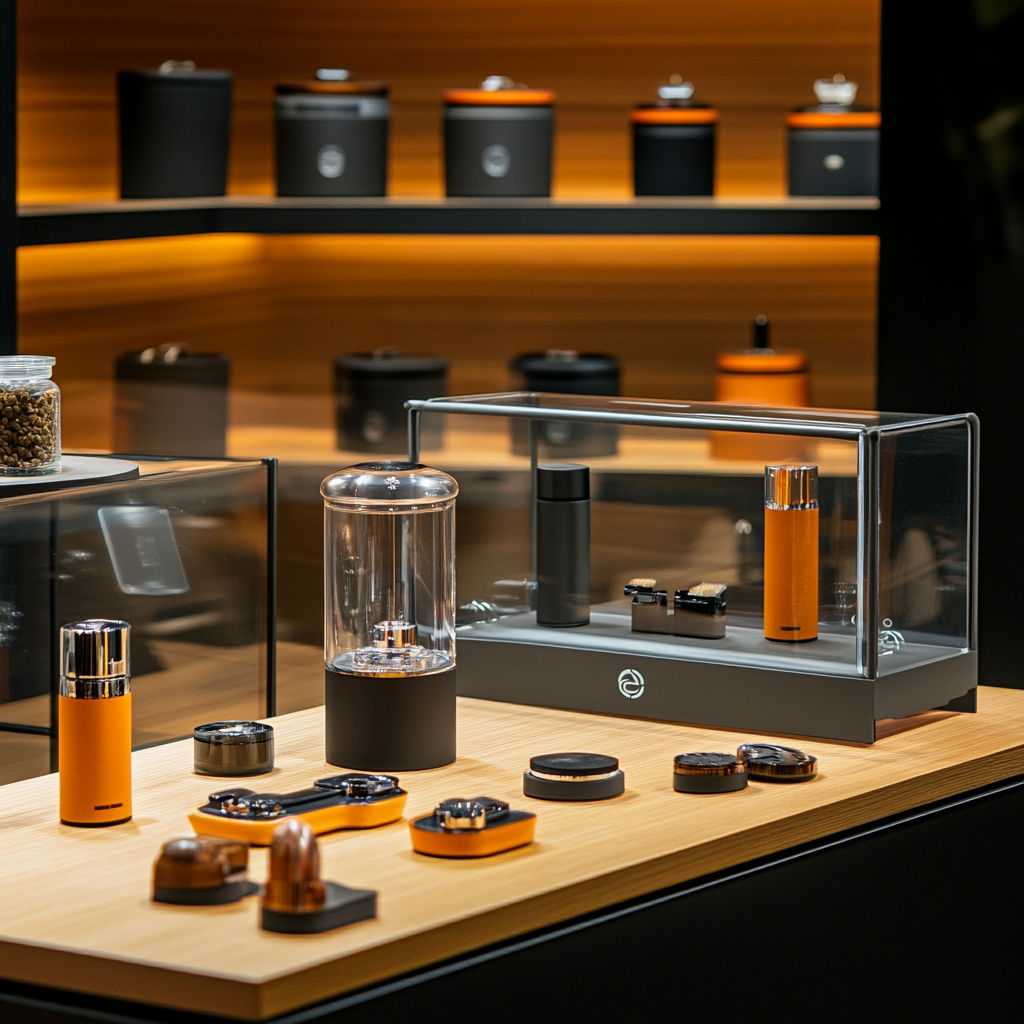
Impulse buying is powerful. It works when products are visible, tempting, and easy to grab. Let’s explore how you can make it happen using key zones.
Placing Hot-Selling Items Near the Entrance
The entrance is prime space. What does visual merchandising do here? It creates instant interest. Customers decide whether to stay within seconds. Use this space for seasonal offers or top sellers. Place popular vapes, rolling papers, or starter kits near the door. Use a tiered glass shelf to elevate them.
Customers walking by will notice. Bright lighting and bold signage make products hard to miss. Highlight any discount or “new arrival” tag. Keep it simple. One table or one showcase is enough. Too much choice can overwhelm buyers. Use clean layouts and easy-to-read price tags.
Offer bundle deals at the entrance. Try a “Flavor Pack” of e-liquids or a combo of filters and grinders. Add a sign: “Only This Week!” Urgency drives decisions. Change this display every week. Regular shoppers will start checking it first. That keeps them engaged. That increases the chances of more sales. What does visual merchandising do with entrance displays? It turns curiosity into action. It gives customers a reason to look—and a reason to buy.
Designing the Checkout Area for Add-On Sales
The checkout zone is your final chance. What does visual merchandising do here? It nudges customers toward extra purchases. Keep this area loaded with low-cost, easy-grab items. Use small acrylic bins or glass trays. Try selling lighters, keychains, single-rolling papers, or flavored filters.
Use signage like “Staff Picks” or “Bestsellers Under $5.” These quick suggestions work well. They speed up decision-making during checkout. Position impulse items directly on the counter or just behind the staff. These should be visible but not block payment space.
Use rotating displays to show variety in small spaces. A spinning rack of compact accessories encourages browsing even while customers wait. Train staff to suggest one item. For example: “Would you like to add a grinder for $3?” Many will say yes, especially if the product is visible.
Offer combo packs here. One vape pen, one charger, and a small pouch. Add a tag: “Perfect Gift Set.” It makes buying easy and fast. What does visual merchandising do at checkout? It finishes strong. It turns one sale into two or more. That boosts your daily revenue with minimal effort.
Creating Focal Points That Capture Attention
Customers often miss items unless you guide their eyes. What does visual merchandising do with focal points? It stops people and makes them look. Create a visual anchor. Use spotlights, color contrast, or an elevated display. Highlight limited-edition products or items with high-profit margins.
Focal points work best at intersections. Think of areas where foot traffic meets—like near the corner of two aisles or beside a featured wall. Use props to make displays fun. For example, place pipes on faux grass, or arrange e-liquid bottles around a mini signboard. These small touches increase visual interest.
Add signs with playful messages. Try “Customer Favorite,” “Just Restocked,” or “Only a Few Left!” These simple cues trigger urgency.
Use height to your advantage. Build pyramids or use multi-tiered shelves. People notice what stands taller than other displays. Digital focal points also help. Use small screens or tablets to play short product videos or slideshows. Movement draws attention naturally.
Keep focal points fresh. Rotate themes every week or during events. Shoppers will learn to look for these changes. What does visual merchandising do with attention? It turns the eye toward products that often get missed. And once seen, they often get sold.
Using Sensory Triggers to Spark Unplanned Buys
Shopping is emotional. What does visual merchandising do with the senses? It stirs feelings that drive impulse actions. Start with scent. Add a light aroma near displays. Try vanilla, mint, or even tobacco-inspired blends. Use scent diffusers or candles to set the mood. A pleasant smell encourages browsing.
Next is touch. Place textured products where people can pick them up. Matte pipes, wooden trays, or soft cases attract fingers. When people touch, they’re more likely to buy. Use lighting to guide attention. Soft light creates calm. Bright white light signals urgency. Use both to steer moods around key impulse zones. Don’t forget the sound. Low background music reduces stress. It encourages shoppers to slow down. That increases the chance they’ll explore and find unexpected items.
Offer small samples if possible. Let customers try a new vape flavor or feel a pipe’s weight. Experience builds connection—and desire to buy. Add QR codes that lead to quick videos. Show how a product works in 10 seconds. Use a stand beside the display. Motion + sound = more interest.
What does visual merchandising do with sensory input? It makes products feel personal. When shoppers connect with a product emotionally, they act fast. Impulse buys rely on feelings, not logic. Sensory details make the difference.
Leveraging Limited-Time Offers in Display Zones
Scarcity sells. What does visual merchandising do with limited-time displays? It creates an urgency that moves products fast.
Use signs that mention time limits. “Only Today,” “This Week Only,” or “Last 5 Units.” These statements spark fast action. Add countdown clocks if possible. Designate one small display for weekly promos. Change it every seven days. Train your team to update the signage and product theme.
Bundle slow-moving stock into deals. Create a “Clearance Corner.” Use red tags and bold fonts. Price matters in impulse zones. Use countdown-style price drops. Post “Now $8, Tomorrow $10.” That drives same-day decisions. The sooner people act, the more they save.
Offer a mystery bag deal. Hide 2-3 small accessories in a sealed pouch. Price it low and label it “Mystery Grab – $5 Only!” People love surprises. Highlight upcoming product launches. Display “Coming Soon” signs beside empty shelves. Leave just enough room to tease. Curiosity leads to later visits—and same-day impulse buys.
Adapting Displays to Trends and Seasons
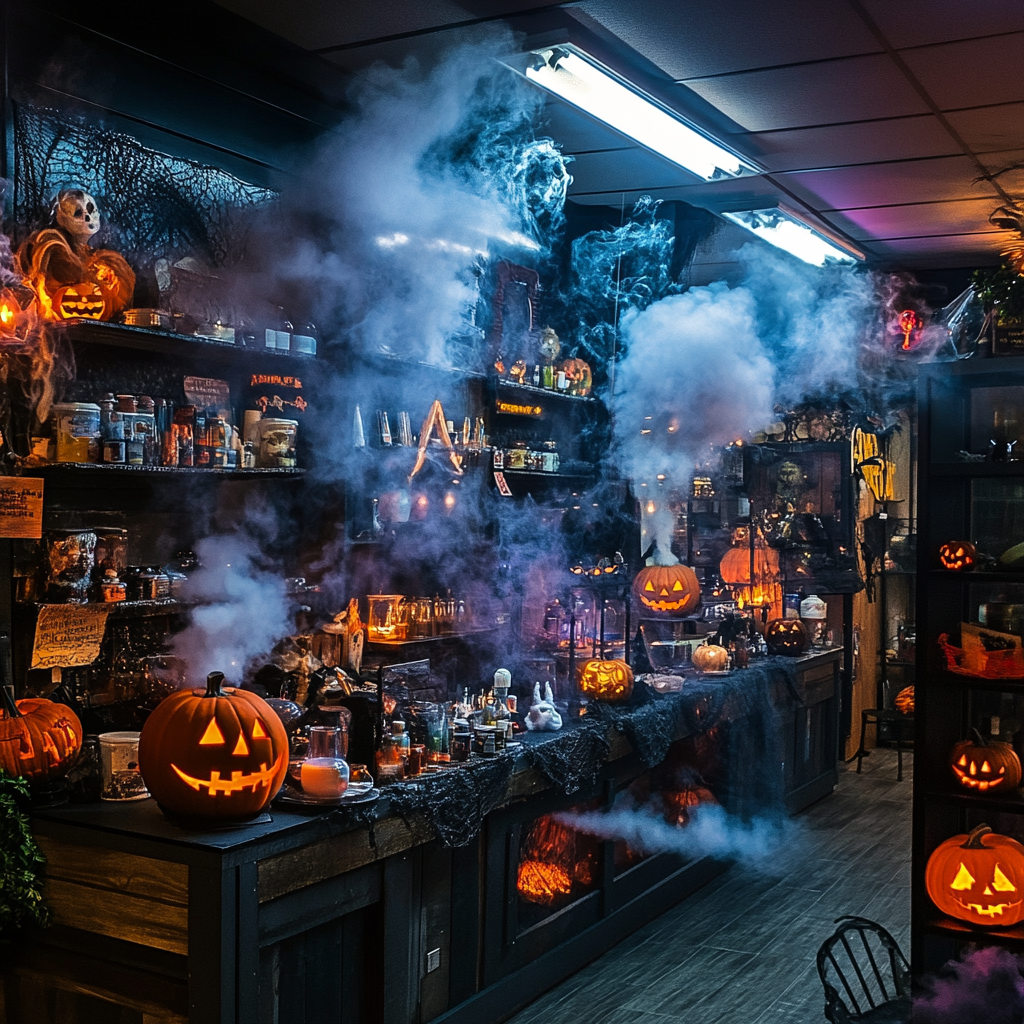
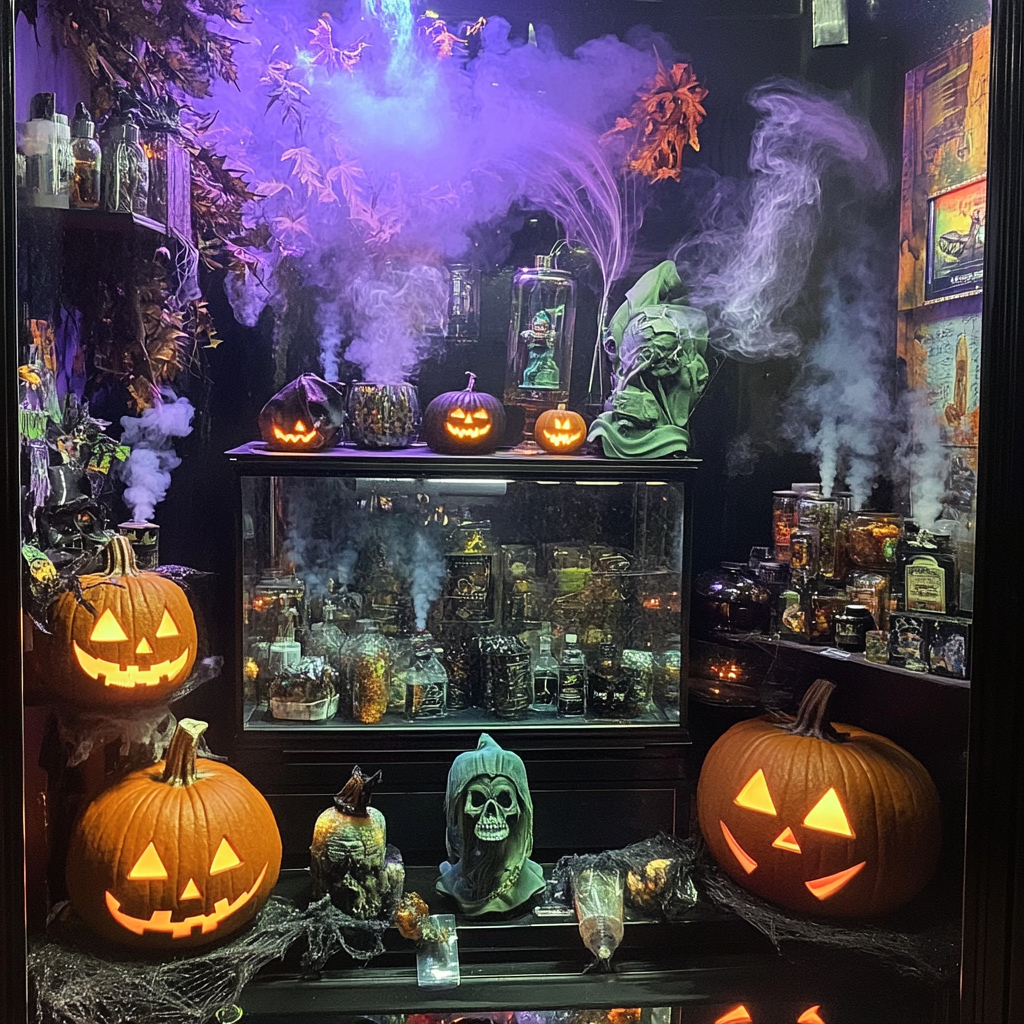
Shoppers return when the store feels new. They trust shops that evolve. Let’s explore how to keep your visuals aligned with the moment.
Updating Displays to Match Seasonal Themes
Seasons bring emotion. What does visual merchandising do with that? It transforms the store to match the mood of the moment. In winter, use cool tones. Add icy blues and whites. Show warm products like torches or insulated pouches. Use lighting to create a soft glow. Spring means renewal. Use light greens and floral visuals. Highlight new arrivals and colorful accessories. Place signs that say “Fresh Picks” or “Just In.”
In summer, go bright. Use bold reds, oranges, and yellows. Promote travel-friendly items like small vaporizers or pocket storage cases. Add beach or festival-themed displays. Fall calls for earthy tones. Think brown, deep orange, and matte black. Show products that offer comfort—like rich flavors or wooden grinders. Use textures like felt or woodgrain.
Use seasonal props. Pumpkins in autumn. Snowflakes in winter. Flowers in spring. These elements build mood. Add signage with holiday countdowns. Promote gifts or bundles during major sales periods. This drives urgency and aligns your store with shopping habits.
Responding to Product Trends in Real Time
Trends change fast. What does visual merchandising do with them? It acts quickly. That’s how you stay ahead. When a new vape model becomes hot, feature it. Place it in a front display. Add signage like “Trending Now” or “Customer Favorite.” Use social media for clues. What are influencers using? What are customers asking about? Bring that energy into your showcase.
Offer a “What’s Hot” section. Change it weekly. Use digital signage or chalkboards. Keep the content visual and brief. Create influencer corners. Print out Instagram photos showing product use. Add them next to real items on display. This builds trust and credibility. Trend-based themes work too. If herbal vapes trend, group-related items. Include grinders, containers, and herbal mix tools. Label the set: “Herbal Essentials.”
Watch supplier catalogs. They often hint at new designs and materials. Adapt your fixtures to suit. Add risers or extra light where needed. Even if you can’t stock every trend, you can reflect them visually. Add posters, props, or signs to stay in sync.
Using Color and Mood to Reflect Cultural Events
Culture shapes behavior. What does visual merchandising do with cultural events? It aligns the store with the calendar.
During Valentine’s, use red. Highlight couple-friendly items. Add heart graphics or love-themed signage. In Pride Month, go colorful. Add rainbow flags or themed packaging. Create bundles of bright products. Place them in your window displays. For Halloween, use dark themes. Set up moody lighting and use props like fake cobwebs. Display novelty pieces like spooky glass pipes.
At New Year, go gold and silver. Add shimmer to your displays. Promote celebration bundles—party-size packs or limited-edition items. Use local holidays too. Celebrate your neighborhood’s identity. If your area holds events, theme your store around them.
Add educational signs. Tell the story behind a cultural celebration. Shoppers appreciate stores that respect diversity and tradition. Music also adds culture. Play themed tunes during these events. Light jazz for winter, reggae for summer. Let sound match your visuals.
Rotating Inventory Displays to Avoid Staleness
Boredom kills sales. What does visual merchandising do to fight that? It refreshes the layout often.
Even if you don’t get new stock, rotate your current items. Move glass showcases from front to center. Switch risers. Swap shelf positions. Customers will see old items as new again. It’s all about placement. Set a weekly rotation schedule. Mondays for front tables. Wednesdays for impulse bins. Friday for checkout trays. This keeps the look moving.
Use colors to refresh the feeling. Add new signage, banners, or backgrounds. Even a new shelf liner makes a big difference. Try theme rotations. One week for grinders. One week for flavor-based displays. Another for accessories. Promote each group in a bold, clear way. Use small chalkboard signs to make changes feel special. “Featured This Week,” “Staff Picks,” or “Back in Stock.” These labels make displays feel active.
Change one major display every seven days. Customers will notice. They’ll return just to see what’s new. Train staff to suggest rearrangements. They see how people shop. Let their feedback guide your rotation plans.
What Does Visual Merchandising Do for Long-Term Loyalty?
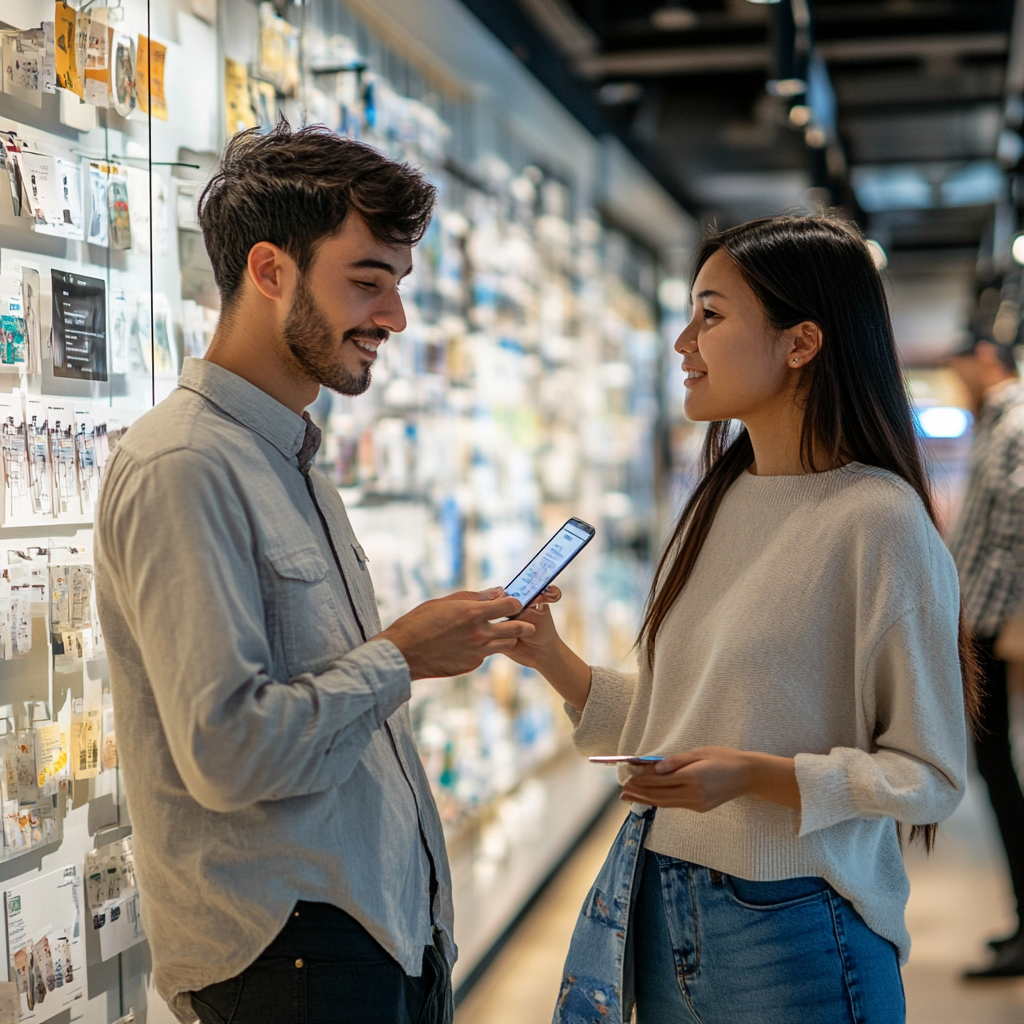

Consistency, comfort, and value all build trust. And trust leads to repeat business. Let’s explore how visual merchandising drives loyalty in smoke shops.
Creating a Familiar and Comfortable Environment
Comfort invites return visits. What does visual merchandising do here? It makes your space feel safe, easy, and familiar. Use a consistent layout. Place categories in the same location each time. That helps returning shoppers find things fast. People love knowing where to go. Keep fixtures steady. Don’t shift major sections too often. Minor updates are fine, but your core structure should stay recognizable.
Repeat your color theme. When customers remember your walls, shelves, and lights, they feel a connection. Familiar visuals reduce friction. Use signature elements. A wooden counter. A green plant near the entrance. A favorite scent in the air. These small touches stick in my memory. Maintain clean, clear signs. Don’t make people guess where things are. Clear visuals build ease. Ease builds comfort. Comfort builds trust. What does visual merchandising do through comfort? It makes your store feel like home. Shoppers return to places that make them feel good. A relaxed customer browses longer. A loyal one comes back again and again.
Reinforcing Your Brand’s Value in Every Visit
Loyalty grows when customers believe in your value. What does visual merchandising do to support that? It reminds shoppers why your store matters. Use signage to restate your strengths. “Best Prices.” “Locally-Owned.” “Expert Picks.” Don’t let customers forget what makes you different. Add visuals that match your mission. If you stand for quality, use well-lit glass displays. Show off the details. Let shoppers see the craftsmanship.
If you stand for variety, organize shelves to highlight options. Use signage like “So Many Choices” or “Pick Your Favorite.” Offer visual proof of deals. Use bundle tables. Highlight “Buy 2, Get 1” offers with bold graphics. Loyalty grows when people feel rewarded. Place testimonials or customer reviews near displays. These remind others that people trust you. Frame handwritten notes or print online reviews.
Keep staff uniforms or aprons in your brand color. That ties into your identity. Customers notice even these small cues.
Encouraging Personal Connection Through Design
People return to places where they feel seen. What does visual merchandising do with that? It humanizes your space.
Start with storytelling. Use photos or framed notes to show your journey. Tell people why you started your store. A small sign at the counter is enough. Add personal displays. “Staff Picks” is a great example. Show names, faces, and favorite products. This builds familiarity and trust. Offer customization. Use a chalkboard wall for customer notes. Let them write reviews or product ideas. People love seeing their voices in the shop.
Create community zones. A table for browsing, a board for events, or a display about local artists. These encourage people to stay and share. Highlight returning customers. Create a “Loyalty Corner” where you thank regulars. List first names or feature favorite products they buy. Use customer photos (with permission). Add them near relevant displays. “Alex’s Favorite Pipe” adds a personal touch.
Supporting a Seamless Customer Experience Over Time
Consistency matters. What does visual merchandising do to support experience? It creates a flow that works every time. Organize your shop in a logical way. Start with attention-grabbing items. Lead people toward bundles. End with clear checkout displays.
Keep display logic steady. Don’t move vape gear from front to back each month. People rely on visual memory. Honor that. Highlight return-friendly policies. Use signs that say “Easy Returns” or “Satisfaction Guaranteed.” These lower risk. Lower risk brings repeat visits. Make checkout simple. Display impulse items clearly. Offer digital screens for receipts or promos. Clear layout = faster service.
Add loyalty program signs. Use visuals to show how rewards work. For example: “Earn 1 Point Per Visit. 10 Points = $10 Off.” Keep this area updated. Show real rewards being used. Display photos of past redemptions. This creates motivation. Include QR codes that link to your website. Let people browse more after they leave. Use similar visuals online for a smooth brand connection. That’s how you earn trust—and repeat business.
Why Fairwill Display?
When I was looking for reliable store fixtures, I needed a partner I could trust. I didn’t want just a product. I needed professional advice, long-term value, and peace of mind. That’s when I found Fairwill Display. Working with Fairwill Display changed everything for my business.
Affordable Solutions Without Sacrificing Quality
As a wholesaler, my profit margins matter. I needed displays that looked premium but didn’t blow my budget. Fairwill Display offered me exactly that. Their prices were competitive. But the quality? It exceeded expectations. Every glass showcase I ordered used tempered glass and E1-grade boards. That means stronger materials, safer products, and better durability. Their prices were clear and transparent. There were no hidden costs. They helped me make the most of my budget—without cutting corners.
Expert Guidance, Not Just Products
I wasn’t sure what layout worked best. Should I use slatwall panels or standalone showcases? What materials would last longer? What fixtures would attract more attention? That’s where Fairwill Display stood out.
Their team didn’t just process my order. They gave me suggestions based on store size, product categories, and local market trends. Their advice helped me avoid design mistakes that would have cost me more later. They asked the right questions and helped me plan the display strategy. Their insights saved me time and money.
Flexible Options for My Business Needs
Every store is different. My customers prefer certain colors and layouts. Fairwill Display gave me choices—size, material, finish, and layout. They even offered custom solutions when I had unique requirements. Because they own their factory, they didn’t say “no” when I asked for changes. They said, “Let’s make it work.”
Fast, Worldwide Shipping
Fairwill Display ships globally. I’m based in Sweden, and my orders always arrive on time. Their packaging is solid. I never received damaged goods. They understood the logistics of international trade. I didn’t have to stress about customs, freight, or paperwork. They handled everything.
Professional Customer Service Every Time
Communication matters. Fairwill Display replied to every question quickly. They shared clear timelines, quotes, and even pictures during production. I never felt ignored. I always felt like a priority. Even after I received the products, they checked in. They asked if I needed setup tips or had questions. That’s rare these days.
I saw the Results in My Store
After I upgraded my displays using Fairwill Display products, I saw the change. My shop looked more organized. My products stood out more. Customers stayed longer. And my sales increased. Good fixtures do more than hold inventory.
If You’re Considering Fairwill Display…
I highly recommend sending them an inquiry. Tell them your needs, your goals, and your budget. They’ll listen. They’ll help. And they’ll deliver. Fairwill Display isn’t just a supplier. They’re a professional partner. They care about your success as much as you do. Ready to upgrade your store? Send Fairwill Display your inquiry today. Let them help you build the store your customers will love.
